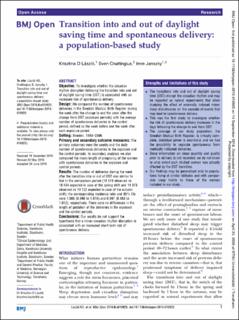| dc.contributor.author | László, Krisztina D. | |
| dc.contributor.author | Cnattingius, Sven | |
| dc.contributor.author | Janszky, Imre | |
| dc.date.accessioned | 2020-04-27T06:55:21Z | |
| dc.date.available | 2020-04-27T06:55:21Z | |
| dc.date.created | 2016-12-07T09:42:03Z | |
| dc.date.issued | 2016 | |
| dc.identifier.citation | BMJ Open. 2016, 6 (9) | en_US |
| dc.identifier.issn | 2044-6055 | |
| dc.identifier.uri | https://hdl.handle.net/11250/2652532 | |
| dc.description.abstract | Objective To investigate whether the circadian rhythm disruption following the transition into and out of daylight saving time (DST) is associated with an increased risk of spontaneous delivery.
Design We compared the number of spontaneous deliveries in the Swedish Medical Birth Register during the week after the change to and the week after the change from DST (exposure periods) with the average number of spontaneous deliveries in the control period, defined as the week before and the week after each exposure period.
Setting Sweden, 1993–2006.
Primary and secondary outcome measures The primary outcomes were the weekly and the daily number of spontaneous deliveries in the exposure and the control periods. In secondary analyses we also compared the mean length of pregnancy of the women with spontaneous deliveries in the exposure and control periods.
Results The number of deliveries during the week after the transition into or out of DST was similar to that in the comparison period (18 519 observed vs 18 434 expected in case of the spring shift and 19 073 observed vs 19 122 expected in case of the autumn shift); the corresponding incidence ratio and 95% CIs were 1.005 (0.990 to 1.019) and 0.997 (0.983 to 1.012), respectively. There were no differences in the length of gestation of the deliveries in the exposure and the control periods.
Conclusions Our results do not support the hypothesis that a minor circadian rhythm disruption is associated with an increased short-term risk of spontaneous delivery. | en_US |
| dc.language.iso | eng | en_US |
| dc.publisher | BMJ Publishing Group | en_US |
| dc.rights | Navngivelse-Ikkekommersiell 4.0 Internasjonal | * |
| dc.rights.uri | http://creativecommons.org/licenses/by-nc/4.0/deed.no | * |
| dc.title | Transition into and out of daylight saving time and spontaneous delivery: a population-based study | en_US |
| dc.type | Peer reviewed | en_US |
| dc.type | Journal article | en_US |
| dc.description.version | publishedVersion | en_US |
| dc.source.volume | 6 | en_US |
| dc.source.journal | BMJ Open | en_US |
| dc.source.issue | 9 | en_US |
| dc.identifier.doi | 10.1136/bmjopen-2015-010925 | |
| dc.identifier.cristin | 1409298 | |
| dc.description.localcode | This is an Open Access article distributed in accordance with the Creative Commons Attribution Non Commercial (CC BY-NC 4.0) license, which permits others to distribute, remix, adapt, build upon this work non-commercially, and license their derivative works on different terms, provided the original work is properly cited and the use is non-commercial. See: http://creativecommons.org/licenses/by-nc/4.0/ | en_US |
| cristin.ispublished | true | |
| cristin.fulltext | original | |
| cristin.qualitycode | 1 | |

